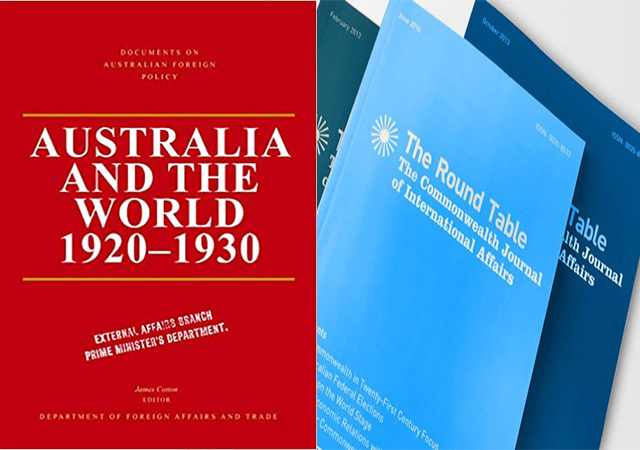
[This is an excerpt from a book review appearing in The Round Table: The Commonwealth Journal of International Affairs.]
For those curious about what ‘the Empire’ meant to Australians only 90–100 years ago, this collection of documents is a godsend. They will be able to read for themselves about the significant issues relating to Australia’s role in the Empire, as seen by political leaders and their advisers during the 1920s. This book is the most recent volume in the series ‘Documents on Australian Foreign Policy’, sponsored by the Australian Department of Foreign Affairs and Trade. While the title indicates a focus on the period from 1920 to 1930, this varies depending on the topic, with the maximum coverage being from October 1918 to October 1933.
The general themes running through the book concern the evolution of the Empire-Commonwealth, and the organisation of Australian foreign policy. Against that background one can study more specific international issues that were of concern to Australia, such as the Washington Conference of 1921–1922, the Chanak crisis of September 1922 (Australia refusing to support Lloyd George against the resurgent Turkish national movement intent on overthrowing the humiliating partitions imposed on the Ottoman Empire under the Treaty of Sèvres of 1920), Antarctica, and various economic issues. The book is organised into eight sections, with each section having a detailed but succinct introduction to the matters covered in that section. Most of the documents come from the National Archives of Australia (fully explained in Appendix II); there is also a very helpful guide to the range of people referred to in the documents (Appendix I). While there is no separate bibliography, there are many footnote references in the introductions to each section. There is no overall chronology but again the introductions are helpful in establishing a timeline. The two indexes, covering people and subjects, are very detailed.
On the issue of the evolution of the Empire, there is often a very strong (and justified) focus on the various Australian prime ministers of this period: W.M. (Billy) Hughes (up to 1923), Stanley Melbourne Bruce (1923–1929), both non-Labor, and James (Jim) Scullin (1929–1931), Labor. Hughes was the great advocate of a strong Australian position within the Empire, identifying as both Australian and British in the wider sense (meaning that Australians were just as British as people living in the United Kingdom). Hughes was very alive to considerations of realpolitik. On the issue of the unity of the Empire versus the autonomy of the Dominions, Hughes opposed the push by Canada at the 1921 Imperial Conference for greater autonomy, arguing instead for stronger Dominion influence within a unified Empire (but without ‘constitutional tinkering’ as he called it). Hughes saw the implications for his preferred position of the arrival of the Irish Free State on the scene in 1922 as the newest Dominion (incidentally to say that this development was ‘not without internal dissension’ in Ireland (p. 15), referring to the Irish Civil War of 1922–1923, is something of an understatement). The documents give a very good insight into Hughes’s thinking. Hughes generally was a strong defender of the White Australia Policy (most notably in opposing the insertion of a racial equality clause in the Covenant of the League of Nations at the Paris Peace Conference in 1919); he nevertheless supported the enfranchisement of Indians resident in Australia.
While Hughes was most forthright with his views on the organisation of the Empire, Bruce (who attended the 1923 and 1926 Imperial Conferences) was more focused on questions of economic development. By the time of the 1926 conference, resulting in the Balfour formula (recognising Great Britain and the Dominions as ‘autonomous Communities within the British Empire, equal in status, in no way subordinate one to another … united by a common allegiance to the Crown, and freely associated as members of the British Commonwealth of Nations’), Australia had lost the contest over the way in which the Empire should be organised. South Africa and Canada (with support also from the Irish Free State) won the day, assisted no doubt by the United Kingdom’s preference to run its own foreign policy without too much Dominion involvement. It is interesting to note the evolution of terminology, with British Empire dominant before 1926, but British Commonwealth of Nations more common thereafter, and even Commonwealth of British Nations.
While Scullin does not figure prominently as a major figure in the articulation of Australian foreign policy, he had a strong interest in social and economic issues, the impact of the Great Depression no doubt concentrating his mind in that respect. He is remembered for maintaining his ground against George V in the appointment of Sir Isaac Isaacs as the first Australian-born governor-general; George V was not against an Australian as such but saw this precedent creating difficulties in more divided contexts such as Canada and South Africa (holding out the possibility of an appointment in one Dominion coming from another Dominion, not just Britain) (Documents 361 and 362). Scullin is lauded from an Australian nationalist perspective, but perhaps George V’s approach might have led in the long term to some appointments to the position of (Australian) governor-general coming from other parts of the Commonwealth (people of the stature of Nelson Mandela or Kofi Annan come to mind).
This collection of documents highlights the role of some outstanding advisers to the Australian government in the evolution of the Empire-Commonwealth.
Derek McDougall is with the University of Melbourne, Australia.
Australia and the world 1920-1930: documents on Australian foreign policy is edited by James Cotton, Sydney, NSW, UNSW Press, for the Department of Foreign Affairs and Trade, 2019.



